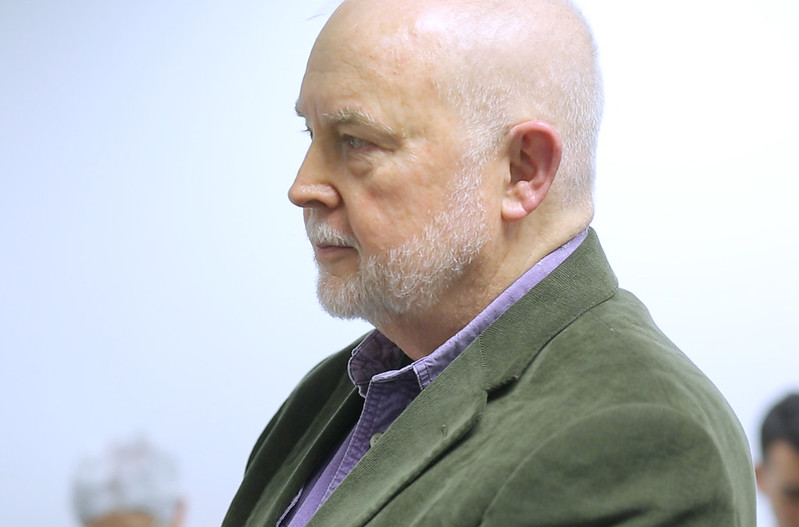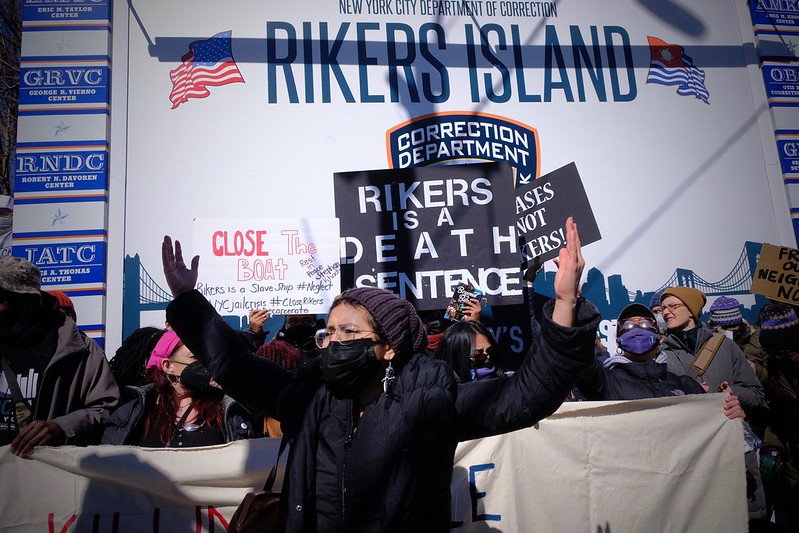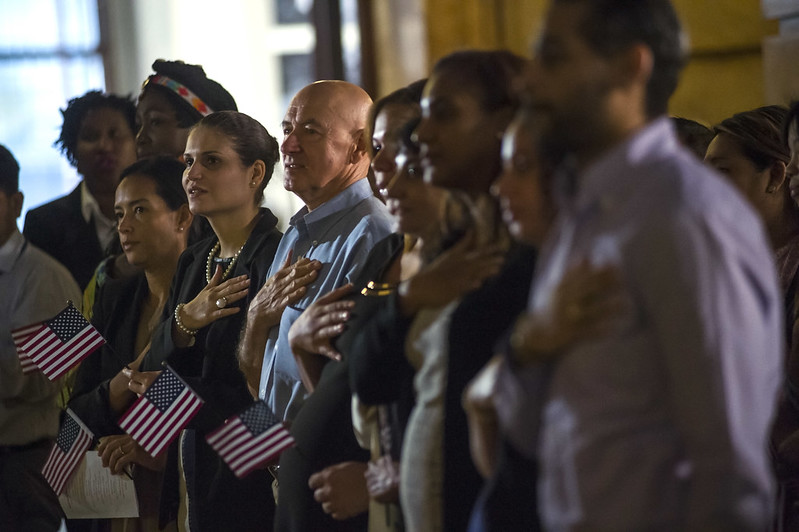The Annual Rent Guidelines Board Charade: Why Rent-Stabilized Tenants are About to be Cheated Again

Michael McKee, the author (photo: William Alatriste/City Council)
The New York City Rent Guidelines Board is getting ready to hit tenants in rent-stabilized apartments with a big rent increase this Tuesday, the largest in nearly a decade.
In its preliminary vote on May 5, the board voted 5-4 for a “range” of increases: between 2 and 4% for one-year lease renewals and 4 to 6% for two-year renewals. While the board is not locked into this, experience tells us that the final vote will be somewhere in these ranges, which will be harmful to the vast majority of tenants forced to pay the increased rent.
This obscure board and its workings are largely unknown to the public, including the 2.5 million New Yorkers living in rent-stabilized apartments. But for more than five decades, its decisions have had a direct impact on the pocketbooks of tenants and the profits of landlords.
The mayor appoints all nine members of the Rent Guidelines Board. Two represent tenants, two represent landlords, and five are so-called public members. The five public members constitute a majority and in most years the vote goes like this: the two tenant members vote against the rent hikes because they’re too high, the two landlord members vote no because they’re too low, and the five public members come in somewhere in the middle with a “reasonable compromise.” It’s an annual charade; the May 5 preliminary vote broke down this way, as no doubt will the June 21 final vote.
Under Mayors Koch, Giuliani, and Bloomberg, most public members were pro-business, and under Bloomberg they were overtly hostile to rent stabilization. Under these mayors the board adopted large rent increases, in some years wildly more than what the board’s data justified.
Mayors Dinkins and de Blasio chose more fair-minded individuals with the result that tenants paid less. De Blasio’s rent board adopted a partial rent freeze in four of the eight years he occupied City Hall. This provided welcome relief to tenants who had been slammed by the Bloomberg board. The excessive Bloomberg rent hikes are baked into stabilized rents permanently, meaning tenants are already paying more than they should.
Mayor Eric Adams will have the chance to replace all the public members as their terms expire, and his actions so far do not inspire confidence. He has made frequent statements about the need to help small landlords, even though the average landlord owns 21 properties. Recently, Adams appointed a new public member, Arpit Gupta, who has made public comments against rent regulation and looks as if he might as well be a landlord member.
Adams is using inflation as an excuse to justify larger rent hikes. But inflation affects tenants as much as, if not more than, landlords. Even a 2 or 3% increase in rent will be harmful to families struggling to pay the ever-rising grocery bill. The median rent in 2021 for rent-stabilized apartments was $1,400 per month. A 2% rent increase at that rent level would be $28 per month, and a 6% hike $84. With median household income for rent-stabilized tenants being $47,000 as of 2020, these monthly increases would create real hardship.
The NYC Rent Stabilization Law of 1969 was written by the real estate industry, in collaboration with Mayor Lindsay, and was designed as the weakest form of rent regulation. While many of the bad features of this law have been corrected by the State Legislature over the years, the Rent Guidelines Board process remains the same. It is high time for reform.
One concrete example: For four decades legislation has languished in Albany that would require City Council confirmation of Rent Guidelines Board members. Checks and balances are the cornerstone of a functioning government and this bill should have been enacted years ago.
Another: Instead of serving a fixed term like the other members, the Rent Guidelines Board chair serves at the pleasure of the mayor, allowing for unwarranted interference in the board’s workings. The current chair, David Reiss, happily went along with de Blasio’s call for a rent freeze, and now seems to be auditioning for a new mayor who has declared that he intends to raise rents.
Except for Dinkins, all mayors have tried to influence the board, whether overtly or behind the scenes. Koch and Giuliani were especially controlling; in some years Giuliani even stated publicly what he thought the numbers should be. Establishing a fixed term would give the chair more independence to act outside of political influence.
Until this process is restructured, this annual charade will play out over the next four years under a landlord-leaning chief executive, to the detriment of tenants.
***
Michael McKee is treasurer of the Tenants Political Action Committee. On Twitter @McKeeTenantsPAC.
***
Have an op-ed idea or submission for Gotham Gazette? Email This email address is being protected from spambots. You need JavaScript enabled to view it.
My Son’s Pretrial Incarceration Shows Everything Wrong with the System

"Rikers is a death sentence" (photo: Gerardo Romo/NYC Council Media Unit)
If you listen to the NYPD Commissioner, you would think that after bail reform was passed in 2019, everyone was released from jail and judges lost all power to send people there. I know from painful personal experience that is false.
Thousands of people are still incarcerated while awaiting trial in New York State, stripped of their liberty before they’ve had their day in court. One of them is my son. For over a year, he’s been on Rikers Island, where an unaffordable bail can turn into a death sentence – like it did just a couple weeks ago for Mary Yehudah. We don’t need to roll back bail reforms to send more people to jail on unaffordable bail, and despite all the fearmongering, New Yorkers know there are better solutions.
My son has struggled with mental health challenges since he was a child. Two years in horrible juvenile detention centers upstate only made his problems worse. He’s a young man now, and he’s spent so many of his formative years – before his brain is fully developed – in one kind of jail or another, exposed to so much violence and so little help. Last year, he had been sleeping on the streets, and was approached by police. The encounter escalated into a confrontation.
At arraignment, his bail was set at $75,000 cash. There is just no way I could pay that amount. I’m a single mother making minimum wage in my human services job. I knew that New York had passed some reforms to the cash bail system, but I couldn’t see any evidence of that in my son’s case. I learned the law now requires judges to consider the person’s ability to pay. How could the judge have considered my son’s financial situation, or mine, and still set bail at $75,000? That’s not a bail, it’s a ransom.
Judges must also offer multiple options for posting bail. One of those options should have allowed me to pay about 10% of the bail and bring my son home, with an agreement to pay the rest if he didn’t return to court. But that option was set at $250,000, over three times the cash bail amount. It was clear the judge was not trying to make sure my son returned to court, he was determined to send him to jail. And he did.
My son arrived at Rikers in May 2021, just days before the Correction Commissioner resigned and a federal monitor issued a report saying that “Staff and Supervisors on the unit are simply unwilling or unable to accept and execute their core responsibilities.” The same month, the City Council held a budget hearing and discovered that an average of 1,300 officers were calling out sick on weekdays, and up to 2,000 on weekends. The crisis continues to endanger the lives of everyone incarcerated at Rikers.
What this has meant for my son is that instead of making sure he returns to court – the supposed justification for pre-trial detention – being in jail is keeping him from getting to court. He’s missed about ten court appearances during his time at Rikers. These delays have only unnecessarily lengthened his time in jail. Last month, the Department of Correction told me he refused to go. But when I heard from him, he said they never told him he had a court date.
My son is far from the only one missing court because of the crisis at Rikers. This is in the same jail system where there were 7,070 missed medical appointments in December, and DOC tried to claim 5,268 of them were missed because incarcerated people refused to go. That’s hard to believe. I know my son’s mental state has deteriorated since he’s been at Rikers. But whether he’s in mental distress and refusing to leave his cell or the guards aren’t showing up to take him, the reality is that being incarcerated is the reason he isn’t showing up in court.
Now my son is considering taking a plea. It’s really tempting – he wants to be home, and he especially wants to get out of Rikers. But it’s not fair. My son, like so many others, was harassed by the police for being homeless, held for ransom by a judge, and denied due process by guards who don’t care about doing their jobs. Where’s the justice in that?
In the NYC Speaks survey conducted this year, New Yorkers named affordable housing and mental health treatment as the two most important investments for a safer city. If the Mayor and other elected leaders are serious about safety, they should shift their focus from attacking bail reform to investing in these resources that could help my son and many others live more stable and productive lives.
***
P. Mass lives in the Bronx, is an advocate and member of Freedom Agenda.
***
Have an op-ed idea or submission for Gotham Gazette? Email This email address is being protected from spambots. You need JavaScript enabled to view it.
DACA at 10: My American Journey and the Work Ahead for Others

A naturalization ceremony (photo: Ed Reed/Mayoral Photography Office)
Ten years ago, the Obama administration announced that people who came to the United States without documentation as children could apply for basic protection on their immigration status. Since then, hundreds of thousands of people have received Deferred Action for Childhood Arrivals (DACA), including an estimated 30,000 DACA recipients in New York City. Without DACA, these young people would be stuck on the margins of American life as undocumented immigrants. I know, because I’m one of them.
On my 12th birthday I awoke before dawn and gathered my belongings. The streets of my home town in central Mexico were quiet as my mom walked with me. My uncle and I left that day to join my father in New York City. As we walked, my grandfather greeted us. He bid me farewell, and it was the last time I ever saw him.
The journey took two weeks. I was nearly kidnapped in the Arizona desert when we crossed the border in the dark of night. For a young child, it was a harrowing experience, compounded by the culture shock of a crowded South Bronx apartment and enrolling in middle school without speaking any English.
Amid the hardships I was still able to make progress. My dad signed me up for extra classes and took English lessons with me on weekends. Working long hours in construction, he put me through college, and I graduated at the top of my class.
Despite that success, I was still an outsider. I was a young college graduate with hopes and ambition. But on paper, I was nobody. Most employers wouldn’t hire me. I couldn’t get a driver’s license or a passport. I could not visit my mom and family in Mexico. Any small mishap could lead to arrest and deportation.
Then DACA was created in 2012. When my application was approved, everything changed. I said “I’m a human here in this country now; I didn’t feel like I was before.” The New York Times printed the quote.
As a DACA recipient, I have been able to do things I could only dream of before the policy was introduced. I earned a Master of Public Administration degree and worked in government helping people access the same services that I was once denied. Eventually I became a U.S. citizen and in 2020 I voted to elect a president of the country I call home. Most importantly, I was able to visit my family in Mexico after 15 years away and spent time with my remaining grandparents in their last days.
Looking Ahead
Democrats in Congress pledged to rebuild a better future for all communities. Despite this, immigrant communities have yet to see substantial action as the Biden Administration is now in its second year in office.
President Biden ran on the promise of a more humanitarian immigration system. He ran on a platform of opposing Trump's actions, establishing our asylum system, protecting and expanding DACA and TPS, and offering a road to citizenship for 11 million undocumented immigrants. President Biden has deported and expelled nearly 1.8 million people in his first year in office, despite his vows to safeguard immigrant communities and end deportations.
Across the country, millions of undocumented immigrants face imprisonment and deportation without a path to citizenship, many of whom have risked their lives as essential workers to keep us safe, nourished, and healthy throughout this pandemic. With deportations and expulsions on the rise under the Biden administration, President Biden must choose between helping Americans and providing a path to citizenship or leaving millions susceptible to the Department of Homeland Security.
For hundreds of thousands of people like me, DACA changed our lives for the better. It gave us a voice. It provided a bright path forward for us after years in the shadows. It recognized our potential to make a difference in this country, and we have. But still there are millions more undocumented immigrants who have been left behind. They need a path forward too. With positive, innovative policies like DACA, there is no telling what opportunities might lie ahead.
***
Luis Rey Ramirez is a Mexican-American immigrant from Queens. He is an active public servant, artist, designer, and videographer with experience as a leader in the nonprofit sector and supporting state and local government, and a champion for LGBT issues.
***
Have an op-ed idea or submission for Gotham Gazette? Email This email address is being protected from spambots. You need JavaScript enabled to view it.




